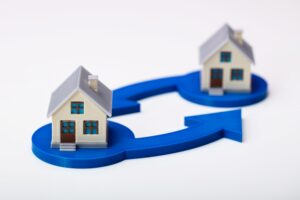The concept of a 1031 exchange and specifically, the reverse 1031 are complex tax deferment strategies that can come in handy for commercial real estate investors. While a good number understand the concept of the 1031 exchange, fewer people understand the reverse 1031 and how to leverage it. So, what is a reverse 1031?
What Is a Reverse 1031?
A reverse 1031 exchange is another way for real estate investors to exchange one property for another without incurring capital gains taxes. Unlike a 1031 exchange, in which you sell a property and then buy another one with the proceeds from that sale; here the process is reversed. In a reverse 1031 exchange, you buy a new property first and then sell the previous property within 180 days for the value of the new property or less.

A traditional 1031 exchange allows you to sell a property and buy a new property using the proceeds of the sale within a given timeframe. A reverse 1031 allows for the exact reverse of that process. You are allowed to buy the new property first, then sell your existing property after doing that.
Requirements of a Reverse 1031
The reverse 1031 exchange has similar requirements to the traditional 1031 exchange. For example, the reverse 1031 exchange can only be applied to commercial investment properties. Other than this there are other certain similar requirements that commercial property investors have to meet to qualify for a reverse 1031 exchange.
Timeline
A reverse 1031 exchange has a similar timeline to other types of 1031 exchanges. You have to choose the property you will be selling within 45 days after buying the new property and you must sell it within the next 135 days. This means that you have 180 days from the purchase to conclude sales.
These are very important and they cannot be extended. If you miss any of these deadlines, the IRS will levy taxes against you.
Same Identity
Despite the need for an exchange accommodation titleholder and a qualified intermediary in this exchange process, the individual selling must be the same person buying.
Like-Kind Property
The IRS has stipulated that only properties of like-kind can be exchanged under the reverse 1031 process. This means that you can only exchange a residential building for another residential building. The same applies to other commercial property types. The IRS also prevents you from conducting an exchange on your primary residence.
Like Value Property
In order to avoid being taxed on capital gains, the IRS requires that the properties being exchanged under the reverse 1031 exchange process should have similar market values or the new property must have a greater value. This means that you are not allowed to replace an existing property with a property of lower market value.
If you do this, the IRS will regard the difference in their market values as capital gains and that will make it taxable.

How a Reverse 1031 Works
There are several instances where you may need to acquire replacement property before you dispose of the existing property in a regular 1031 exchange. Sometimes, a time-based investment opportunity may appear and you may not have enough time to consider the property you want to sell-off.
You may have even started the process of a regular 1031 exchange and the sale of your existing property collapsed unexpectedly. You will need to act fast if you do not want to lose the acquisition.
This is what makes the Reverse 1031 a very strategic tool for commercial property investors. Here is how the reverse 1031 exchange works:
Find a Replacement Property and Determine Funding
The first thing you have to do is to find a suitable replacement property you are interested in. You then have to determine how you will fund the purchase; with cash, short-term private money, or conventional financing.
Whichever choice you eventually make, you have to inform the title company and the lender, where necessary, that you are performing a reverse 1031. This is important because they may have varying policies as regards reverse 1031 exchanges.
Determine Your EAT and QI
In a reverse 1031 exchange, you are not allowed to hold the titles of both the existing property and the replacement property at the same time. This is why you need an Exchange Accommodator Titleholder (EAT). Their duty is to hold the title of the new property while you acquire the new property.
You will have to enter into a Qualified Exchange Accommodation Agreement (QEAA) with your EAT. The QEAA will serve as a formal agreement stipulating the terms of the exchange.
You also have to determine your Qualified Intermediary (QI) and establish a contract with them. Your QI will be responsible for transferring the title of the existing property to the new buyer and transferring the title of the replacement property to you from the EAT after the deal is completed.
Buy the Replacement Property
The next thing to do is to buy the replacement property. To do this, you will have to enter into a Purchase and Sales Agreement (PSA) with the seller. Keep in mind that, to avoid being taxed on capital gains, the replacement property must be of equal or greater market value to the existing property.

EAT Takes Over the New Title
Once you have financed and completed the purchase of the replacement property, the EAT will take over the title of the new property and hold it till the exchange is done.
Determine the Property/Properties to Sell
Once the EAT is in possession of the title of the replacement property, you have 45 days to identify or change the existing property you want to sell. You are allowed to sell up to three properties provided these properties are equal to or less than the value of the replacement property.
Sell the Existing Property and Transfer the Deed to the Buyer
After determining the property to sell, you have another 135 days to complete the sale of the existing property. Before the expiration of this deadline, you must enter into a PSA with the new buyer. Your QI will prepare the necessary documents for the sale and the transfer of the title to the buyer.
Obtain the Deed of the Replacement Property
You have a total of 180 days from the purchase of the replacement property to close on the sale of the existing property. Once you have successfully closed the deal, your QI will handle the transfer of the title deed to you from your EAT.
If you meet the timeframe requirement and all other requirements, you will be eligible for a tax deferral on the proceeds of the sales of your existing property.
Benefits of a Reverse 1031
A reverse 1031 exchange holds a lot of advantages for investors and it can be a strong tool if leveraged well. Here are a few major benefits of using a reverse 1031:
- The primary benefit of the reverse 1031 is the safe harbor that the Revenue Procedure 2000-37 offers. These arrangements provide numerous tax benefits to commercial real estate investors.
- A reverse 1031 can give you an edge in a competitive market with fluctuating prices. You can easily lock in a new property at a convenient time and price.
- It also gives you more than enough time to consider and determine which of your existing properties you will be selling. It also gives you ample time for negotiations before closing.
- Like the traditional 1031, it provides you the freedom to defer capital gain taxes to a much later date in the future.

Challenges of a Reverse 1031
Despite its benefits, the reverse 1031 exchange is more complex than the traditional 1031 exchange and as such, it comes with quite a few challenges.
- The first of these challenges is the need for meticulous planning. Securing financing can be difficult, so you have to map everything out so that you meet the deadline. Failure to meet the deadline will mean having to pay taxes on any capital gain and missing out on any favorable tax treatment.
- A reverse 1031 can also be more costly than the traditional 1031 because of the increased involvement of third parties. Some states may require you to pay transfer tax when transferring the titles with the EAT.
This is one of the major reasons you should have your 1031 exchanges handled by a team of commercial real estate experts like Si Vales Valeo Real Estate. We have vast experience in advising and handling transactions including reverse 1031 exchanges. We are your best shot if you are looking to invest in the Cincinnati MSA.
Frequently Asked Questions
Can You Live In Your Reverse Exchange Property?
Yes, you can. However, reverse 1031 properties are restricted to only commercial real estate. You can only convert a reverse 1031 property into a residence after the close of the exchange in line with the IRS’ rules.
Can You Sell a Reverse 1031 Property to Your Family Member?
Yes, you can sell a reverse 1031 property to your family member. However, they are not allowed to resell it within the following two years.
Conclusion
Regardless of its complex nature, the reverse 1031 is a very valuable tool every commercial real estate investor should exercise. However, because they are more complex than other types of 1031 exchanges, they require thorough planning. It is always best for investors to utilize the help of professionals to help save lots of costs when selling commercial property.






